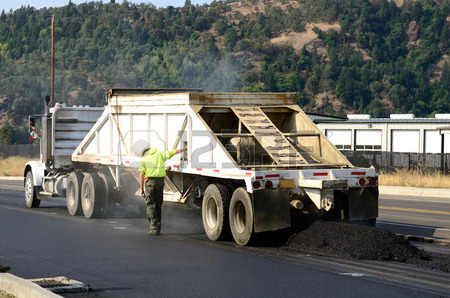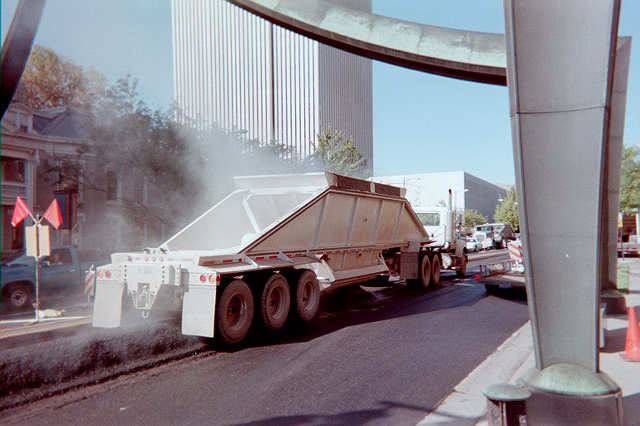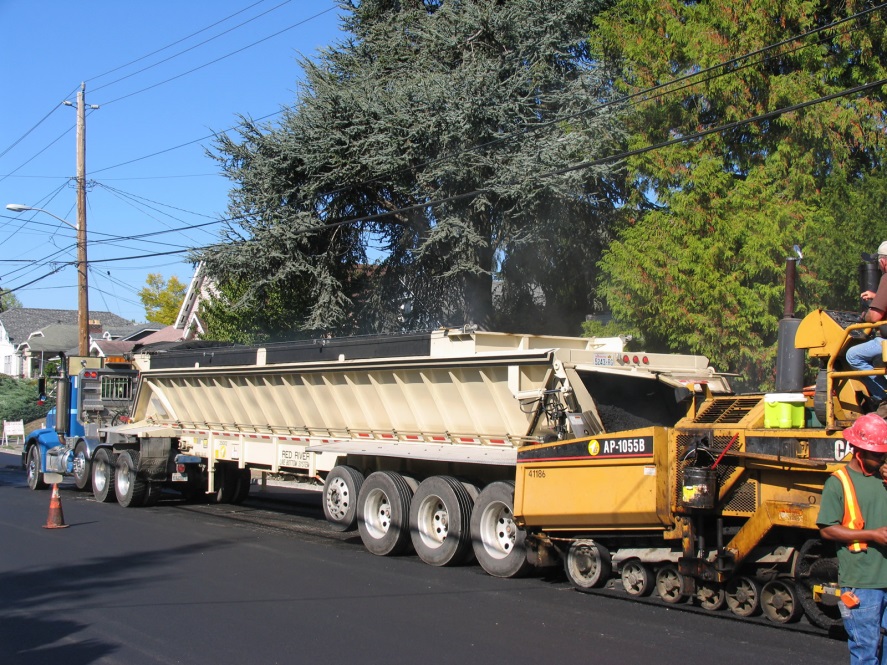6.2 Truck Types
There are three basic truck types used for mix transport classified by their respective HMA discharge methods:
- end dump,
- bottom dump (or belly dump),
- live bottom (or flo-boy).
6.2.1 End Dump Truck
End dump trucks unload their payload by raising the front end and letting the payload slide down the bottom of the bed and out the back through the tailgate (see Figure 6-13). End dump trucks are the most popular transport vehicle type because they are plentiful, maneuverable, and versatile. Some general considerations associated with end dump trucks are:
- When the bed is raised, it should not contact the paver. Bed contact with the paver may affect the screed tow point elevation, which can affect mat smoothness.
- The truck bed should be raised slightly before the tailgate is opened. This allows the HMA to slide back against the tailgate, which will cause it to flood into the paver hopper when the tailgate is opened. HMA that trickles into the paver hopper is more susceptible to aggregate segregation.
- Truck-paver contact should be established by allowing the paver to move forward into a stationary truck. This ensures that the truck does not bump the paver too hard and cause the paver to lurch to a sudden stop, which could cause a rough spot in the mat.
- Once the paver and truck are in contact, they should remain in contact.This ensures that no HMA is accidentally spilled in front of the paver because of a gap between the truck and paver. Usually, the truck driver will apply the truck’s brakes hard enough to offer some resistance to the paver but light enough so as not to cause the paver tracks to slip from excessive resistance. Most pavers can also be coupled to an unloading truck using truck hitches located on or near the push rollers.

Figure 6-13. End Dump Truck.
6.2.2 Bottom Dump Truck
Bottom (or belly) dump trucks (see Figure 6-14) unload their payload by opening gates on the bottom of the bed. Internal bed walls are sloped to direct the entire payload out through the opened gates. Discharge rates can be controlled by the degree of gate opening and the speed of the truck during discharge. The discharge is usually placed in an elongated pile, called a windrow (see Figure 6-15), in front of the paver by driving the truck forward during discharge.
A windrow elevator is used to pick up HMA from the windrow and feed it into the paver hopper. Windrow elevators do not have any method of regulating material flow, which makes it necessary to place the correct amount of HMA in the windrow to match the paving width and depth being placed without allowing the paver hopper to run out of mix or become overloaded.

Figure 6-14. Bottom dump truck. © Copyright 2006 University of Washington

Figure 6-15. Windrow made by emptying a bottom dump truck. © Copyright 2006 University of Washington
6.2.3 Live Bottom Dump Truck
Live bottom (or flo-boy) dump trucks (see Figure 6-16) have a conveyor system at the bottom of their bed to unload their payload. HMA is discharged out the back of the bed without raising the bed. Live bottom trucks are more expensive to use and maintain because of the conveyor system, but they also can reduce segregation problems (because the HMA is moved in a large mass) and can eliminate potential truck bed – paver contact (because the bed is not raised during discharge).

Figure 6-16. Live Bottom Truck. © Copyright 2006 University of Washington
Each truck type is capable of adequately delivering HMA from a production facility to a paving site. However, certain situations, such as the ones listed in “Table 6-2: Truck Type Advantages” below, may make one truck type advantageous over another.
Situation | Possible Truck Type | Reason |
|---|---|---|
Paving on congested city streets | End Dump | Better maneuverability because it has no trailer and is smaller than a bottom dump or live bottom truck. |
Paving using a mix highly vulnerable to segregation | Live Bottom (Flo Boy) | Live bottom trucks deliver the HMA by conveyor, which minimizes segregation. |
Paving on rural highways | Bottom Dump (Belly Dump) | Usually has a larger capacity than end dump trucks (therefore fewer trucks are needed), but requires space and equipment for windrows. |